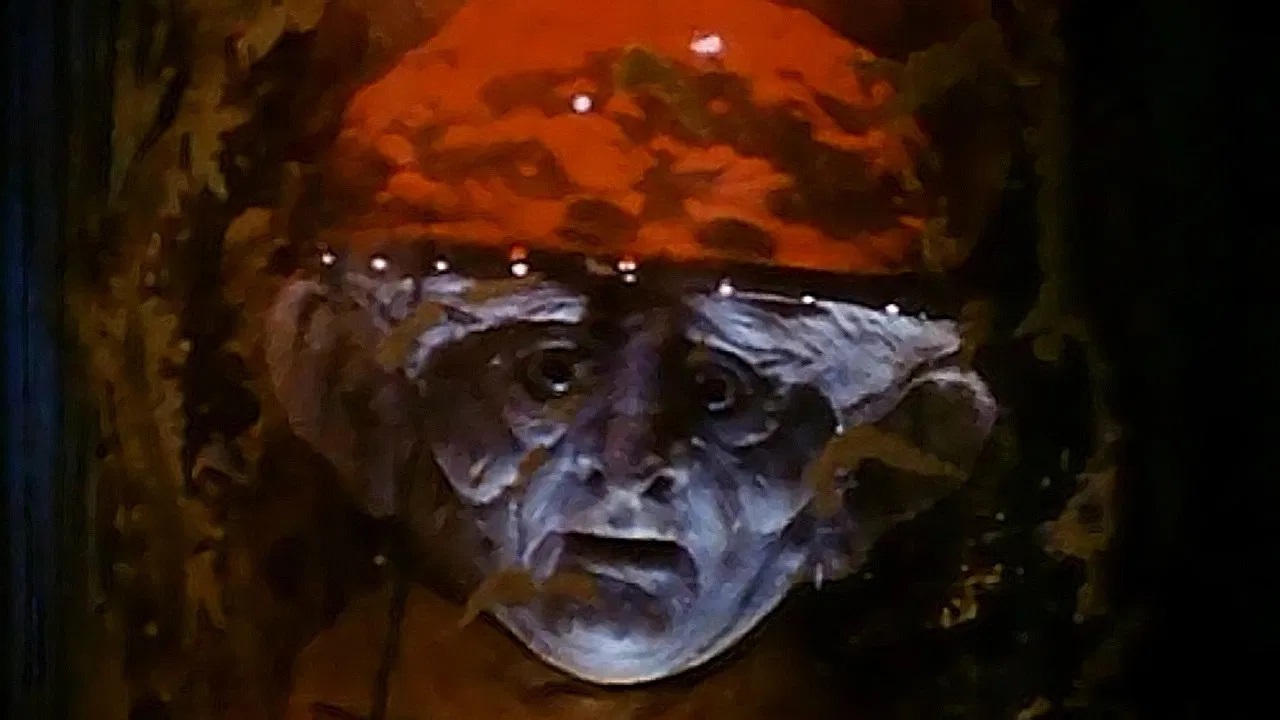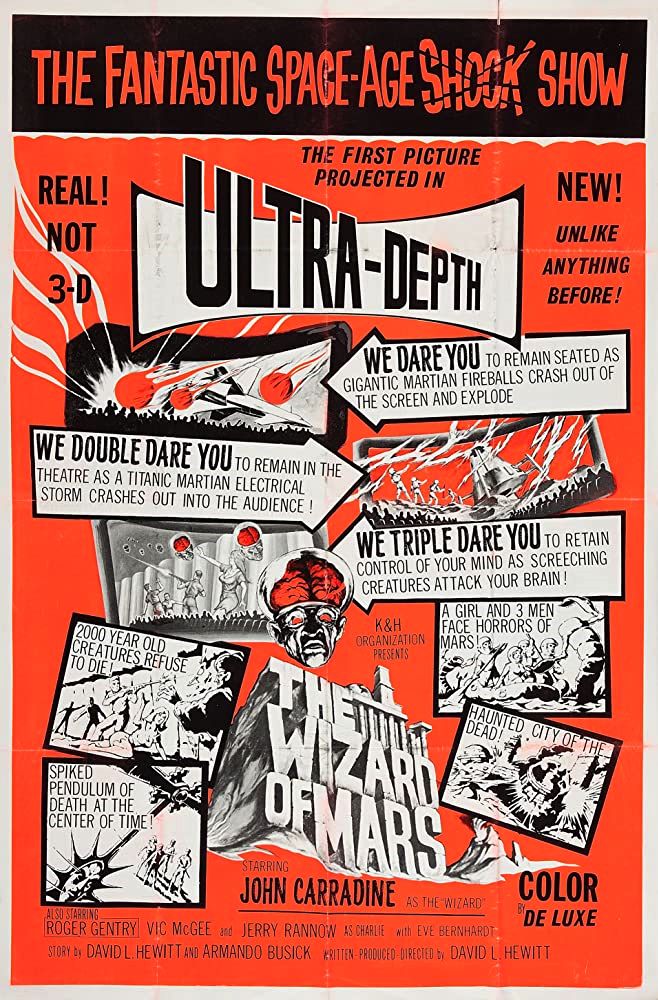USA. 1965.
Crew
Director/Screenplay/Producer – David L. Hewitt, Story – Armando Busick & David L. Hewitt, Photography – Austin McKinney, Electronic Effects – Frank A. Coe, Special Photographic Effects – Cinema Research, Makeup – J. Lister, Art Direction – Armando Busick. Production Company – David L. Hewitt & Associates.
Cast
Roger Gentry (Steve), Vic McGee (Doc), Jerry Rannow (Charlie), Eve Bernhardt (Dorothy), John Carradine (The Wizard)
Plot
January 1st, 1975. Mars Probe 1 is conducting a flyby of Mars when the crew encounter a magnetic barrier that causes the ship to crash. On the planet’s surface, the crew are forced to survive with limited oxygen supplies. They make their way down the canals in an inflatable raft and then through caves filled with volcanic lava. Just when their air supplies are running out, they come across an old Mars lander and use its oxygen supplies. They then discover a gold brick road that leads to the ruins of an ancient Martian city. There they find the mummified remnants of the Martians. They meet a manifestation of the Martian collective, which tells them how the Martian people conquered the whole universe and then preserved themselves beyond time in an effort to conquer death. It asks one task of them – restarting time so that the Martians can die at long last.
The Wizard of Mars comes from David L. Hewitt, a director/producer whose handful of films have all been down the bottom end of the B-budget spectrum. Hewitt’s other genre films have included Dr Terror’s Gallery of Horrors (1967), Journey to the Center of Time (1967), The Mighty Gorga (1969) and The Lucifer Complex (1978).
The Wizard of Mars has a reputation that is just as dreadful as the rest of David L. Hewitt’s films. The surprise upon seeing The Wizard of Mars is that it is not as terrible as has been made out and is almost a decent film in many regards. Certainly, it is made with special effects that would have been fairly convincing for the period the film was made, including some good planetary scapes and model effects.
The Wizard of Mars may well have been an attempt by David L. Hewitt to copy the success of the previous year’s Robinson Crusoe on Mars (1964), a survival story about an astronaut trying to cope after crashlanding on Mars. There is a fair survival story here – as long as one is prepared to tune out any scientifically accurate vision of Mars – with some discussion of the problems navigating and how to find oxygen supplies.
The journey through the frozen tundra, canals and caverns of burning lava has an undeniable alienness. The scenes on the surface with sand dunes all in blue and skies that have been tinted orange look strikingly effective. As one of the party says, “It makes the sands look dreamlike” – and for once, it is a description that is perfectly true. The meeting with the mummified grey-skinned alien in a glass canister with a brain exposed and lit up by a glowing red light is unearthly. There is a soundtrack composed of ‘electronic tonalities’ along the lines of Forbidden Planet (1956).

David L. Hewitt’s writing does tend to fall into cliche imponderables when it comes to the Wizard’s monologue – “space is vast, time is long … It was then that we impaled time on an axis … eternal stillness, transgression upon time … Time tugs us to our yesterdays almost as strong as all the unborn tomorrows that stretch through all eternity.” [Hewitt was clearly so enamoured of the profundity of this piece of dialogue that he lifted sections of it and reused them for the opening narration of Journey to the Center of Time].
Hewitt’s customary cheapness does eventually set in – the attack by the crab creatures, which look like pieces of corrugated tubing, is thoroughly unconvincing; the initial part of the journey through the caverns takes place in cramped quarters – the party talk how the raft is moving towards something, where they are clearly perfectly still, and keep describing things that only happen off screen; while the Martian city seems to be represented by the same single stretch of corridor.
The greatest footnote The Wizard of Mars has is that it is an uncredited science-fiction version of The Wizard of Oz (1939). There is a certain cleverness to the way that the film creates science-fictional interpolations of the imagery from The Wizard of Oz – the Yellow Brick Road ingeniously becomes the ruins of a highway leading to the Martian city; while John Carradine stands in for The Wizard, appearing as a head that is an embodiment of the Martian consciousness.
The Wizard of Oz analogy has perhaps been overstretched. There are just as many non-parallels – there is no equivalent of The Wicked Witch of the West or the Munchkins, for instance, and the head of The Wizard does not eventually turn out to be an illusion created by a charlatan. Nor for that matter are there any equivalents of Dorothy’s companions – The Tin Woodsman, The Scarecrow and the Cowardly Lion. There is however a party of four astronauts. And between the Neanderthal and blockheaded Doc (Vic McGee); the brash Charlie (Jerry Rannow) whose natural impulse is to shoot everything he sees; and the token woman (Eve Bernhardt) who barely gets to speak, nor is even referred to by her name throughout, this does seem an expedition that is decidedly in need of some brains. The film should at least be commended for playing its science-fiction version of The Wizard of Oz surprisingly straight.
Full film available here


